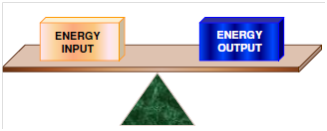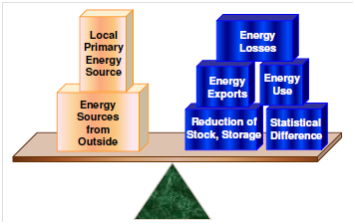Preparation of Energy Balance
An energy balance is a set of relationships accounting for all the energy which is consumed and produced. It matches inputs and outputs in a system over a given time period.

Figure: Energy Balance Matches Energy Input with Energy Output in a System
The system could be the whole country or a limited area or even a procedure in a factory. An energy balance is commonly made with reference to a year, though it could also be made for consecutive years to show variations over time. Energy balances are used to quantify the energy used or produced through a system.
These are commonly constructed from two sides:
1) From end-uses back to total primary energy consumption, and
2) From resource extraction to basic energy supply. The basic equation of an energy balance is:
Source + Import = Export + Variation of stock + Use + Loss + Statistical differences
In this given equation,
1. Sources are local primary energy sources;
2. Imports are energy sources that come from outside the area under consideration (e.g., the country, region, village, etc.);
3. Exports go to other areas (countries, regions, etc.);
4. Variation of stock is reduction of stock (wood, oil) and storage;
5. Use could be specified sector-wise or through energy form or by end-use. This includes use of fuels for non-energy purposes;
6. Losses can be technical and administrative;
7. Statistical difference is involved to balance for inaccuracies in supply and demand, for example, due to evaluation of losses. These statistical differences could sometimes be as high as 10%.

Figure: Schematic Diagram for the Energy Balance Equation
We required quantifying all these quantities although preparing the energy balance for energy accounting. A significant part of preparing an energy balance is the construction of an energy chain to trace the flows of energy inside an economy or system, beginning from the primary source(s) of supply by the processes of conversion, transformation and transportation, to final/delivered energy and finishing along with end-use.
All too often, energy balances are constructed in terms of primary energy without taking within account conversions or transformations. This could lead to incorrect conclusions. The most common example is electricity that is a secondary form of energy. Electricity is commonly involved in a primary energy balance on the primary of the amount of fossil fuel required to generate it. Or, when electricity is generated from hydro, renewable energy resources or nuclear energy, an energy equivalent or heat content is used.
Therefore, it is not simply a matter of taking a conversion of one single fuel to another, because of the conversion efficiency varies along with the primary energy source. For example, for hydro it is around 90 percent, whereas for coal it is around 40%.
The amount of energy need to generate electricity should reflect these differences. For example, it would take at least double the amount of energy to generate one unit of electricity if coal were used on the other hand of hydro.
An energy balance should involve the accounting of commercial energy, non-commercial energy, non-energy products, and energy imports and exports.
We now briefly explain what is included in this.
a.) Commercial Energy: It should be clearly specified that energy forms are involved in commercial and non-commercial energy categories.
b.) Non-commercial Energy: Non-commercial energy commonly includes biomass (woody and agricultural residues) and animate energy. Despite their significant contribution to the energy supply, particularly in rural areas, these sources do not commonly appear in national energy balances. They are hard to quantify physically since they are traded and used in non-standard units. Their flows are not monitored because they fall outside the purview of the monetised economy. A few countries now involve agricultural processing residues, such as bagasse and rice husk, in their energy balances.
c.) Non-energy Products: These involve products from primary energy carriers such as petrochemicals from crude oil, coal and natural gas and should be listed separately.
d.) Energy Imports and Exports: These involve imports, exports, storage, stock changes, transformation (conversion of one fuel to another, for instance, coal to coke), distribution and conversion losses as well as self consumption through the energy industry (if relevant). These must be involved although constructing an energy balance for the Energy Accounting System.
Energy balances gives overviews, and constitute basic energy planning tools for analysing the current and projected energy situation. The overviews aid sustainable resource management implies options for energy saving, or for policies of energy pricing and redistribution and etc.
Having elaborates the concept of energy balance; we would like to discuss the measurement and separation of commercial and technical losses.